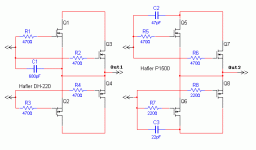well, my beard ain't grey yet, but i'll take a whack at it...... i've noticed that even with complementary pair mosfets, there are differences in gate capacitance between N and P channel devices, with the result that the N channel devices are a bit faster than their P channel counterparts, and so harder to tame. the trick is to tame instability, while maintaining equal phase response and slew rate for both sides of the output pair, and so Hafler does so, possibly finding the proper component values experimentally. the output devices, although complements, are not entirely symmetrical in all of their characteristics.
The original post sounded like a statement--then it morphed into an implied question, but I'm still not clear as to exactly what the question was.
Are you asking about the Gate stoppers, the caps, the MOSFETs, or the topology as a whole?
What MOSFET nasties were you referring to? Oscillation? You'll find much the same sort of layout in bipolar designs. Tubes, too, for that matter, making allowances for the lack of 'P-ch' devices.
Grey
Are you asking about the Gate stoppers, the caps, the MOSFETs, or the topology as a whole?
What MOSFET nasties were you referring to? Oscillation? You'll find much the same sort of layout in bipolar designs. Tubes, too, for that matter, making allowances for the lack of 'P-ch' devices.
Grey
looking at the hafler dh-220 service manual, i see that the driver for the PCH half is heavily compensated, and the NCH half is not compensated at the driver, but at the output device.
one design goal i am familiar with in hafler amps is symmetrical slew rate, and as i was told long ago.... if it works, don't fix it......
one design goal i am familiar with in hafler amps is symmetrical slew rate, and as i was told long ago.... if it works, don't fix it......
- Status
- This old topic is closed. If you want to reopen this topic, contact a moderator using the "Report Post" button.
- Home
- Amplifiers
- Solid State
- Taming MOSFET nasties: Hafler
